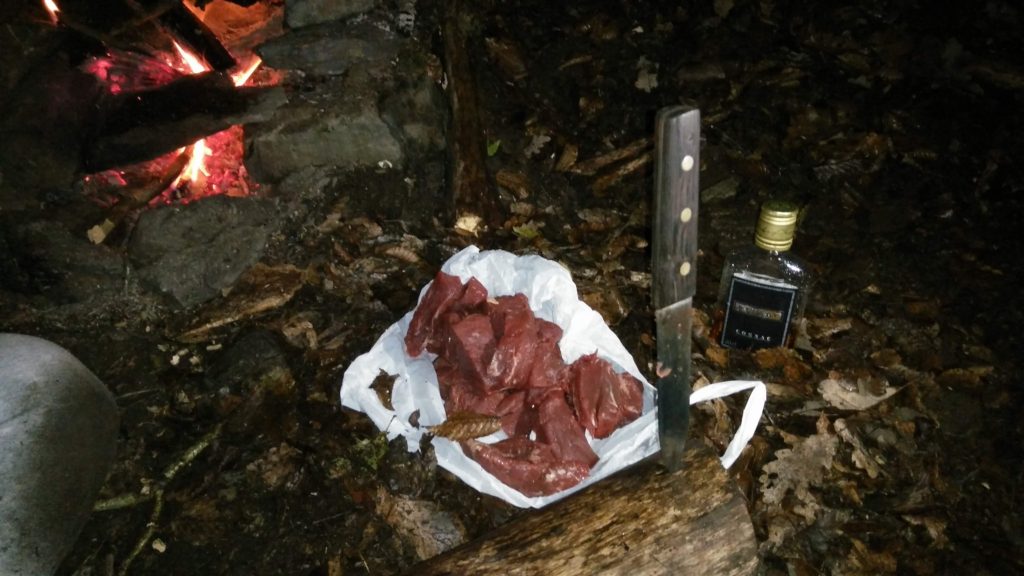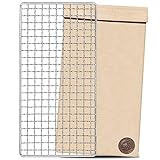
Cooking in the wild without any gear can be very challenging if you are inexperienced. The truth is, it’s not that hard if you know what you are doing. In this article, I will teach you how you can cook without any gear at all. The only assumption I’m going to make is that you have a fire. For those of you who don’t want to go full survival and who are willing to bring some gear with you, stick around. At the end of this article I will discuss what gear you should bring for an optimal experience.
Cooking in the wild: quick overview
Cooking in the wild is probably not as hard as you think it is. Everything comes down to being able to boil water and being able to cook your meat, fish or other food.
Cooking meat, fish or other things is actually really easy. The only thing you need is a fire and a flat rock. A flat rock can perfectly function as a cooking plate.
If you don’t have cooking oil, you want to make sure that the rock is really hot when cooking steak or something similar. If the rock isn’t really hot, your meat can easily stick to the rock.
When it comes to boiling water, you will have to find/improvise a water container. Once you have a water container you can place on top, above or next to the coals. Alternatively, you could heat up some rocks and place these rocks inside your water container when they are really hot. This will cause your water to boil.
Improvise a cooking plate


Let’s start with the easiest part, improvising a cooking plate. You might have something with you that could function as a cooking plate. However, if you don’t have anything with you, you could simply look for a flat rock that is big enough to cook something on.
Once you have your cooking plate, you need to build something where you could put your plate on. Building an improvised oven with rocks is always a good option.
If you are unable to find a good cooking plate, you could always consider cooking your meat/fish directly on the coals. This might sound weird at first, but it’s actually rather common, especially with steak. This is called caveman steak.
If you want to do it caveman style, make sure that you have a clean bed of coals. You don’t want to throw your meat directly into the fire. Note that if you put your meat on top of the coals it might produce some flames, this is normal.
If you don’t want to go through the trouble, you might want to consider bringing a small grill. This can make your life a bit easier and it doesn’t weigh that much.
Improvise a water container
More challenging than improvising a cooking plate is improvising a water container.
Now there are a lot of things that could function as a water container. A regular bowl, a whole in a log, a plastic bottle, a paper bag, etc.
Now the surprising thing is that you could use any of the examples listed above to create boiling water.
A plastic bottle, for example, can be placed on top of the coals until the water is at boiling temperature. The bottle itself might deform a little bit and the boiled water might not be the best tasting water in the world, but it will be safe to drink.
Even a paper bag won’t burn when you place it on top of the coals. The water inside the bag will actually prevent the bag from burning.
Make your own bowl
If you don’t have anything with you that could function as a water container, you will have to make your own bowl.
The most effective way to create a bowl is to place some burning coals on top of a log and use these to create a hole in the log. Blow on the burning coals or create a small fire if needed. Once the hole is big enough, use whatever you can find to clean it. The most effective way is to use sand and give it a good rub. After that rinse it with water.
The fact that your bowl is rather heavy and clumsy doesn’t really matter because you will use rocks to boil that water.
Boiling water
Most of the time, when you are cooking in the wild, you are going to need boiling water. As I said before, you could either boil your water by placing your water container on top of the fire or coals or you could use stones.
Regular boiling
It might seem surprising that you can almost use any water container to boil your water. Even plastic bottles or paper bags can be used.
Make sure that you place your bag, bottle or bowl on top of some hot coals. Don’t put it directly in a fire.
If you don’t trust me, there are plenty of Youtube videos or articles on the topic.
Stone boiling
A more interesting way to boil your water is stone boiling. When you stone boil your water, you want to place egg sized stones in/around the fire.
Once these stones are really hot, you want to rinse them and place them inside you water container. The heat of the stones will cause your water to boil.
This is especially handy when you use a log as a bowl. You don’t even have to move your boil, you just need to put some hot rocks in it.
Cooking with gear
Cooking in the wild without any gear is definitely possible. However, having a minimal set of cooking gear is definitely convenient. I don’t really mind cooking on a stone, but creating my own bowl can be very time consuming. Therefore, I will usually bring at a least a bowl with me on any hiking/camping trip (unless I really want to go full survival mode).
That said, you don’t want to bring too much gear on a hiking trip either. You want to keep the weight of your backpack as low as possible.
Therefore, I tried to find the best lightweight and budget friendly cooking items you could bring on your next hiking trip. By the way, there are plenty of high quality products in the low budget category when it comes to camping cooking gear.
Lightweight grill
When it comes to a simple lightweight grill, I would recommend the DRIX Outdoors Campfire Grill. This grill is lightweight — but still large compared to most competitors — and it’s high quality.
You might find an even lighter grill, but these will be smaller as well. My reasoning is, if you want to go ultralight, don’t bring a grill at all. If you are going to bring a grill, better bring a decent one.
If you have a small lightweight grill laying around somewhere, you can probably use that as well. You don’t need the highest quality grill. The main requirement is that it’s lightweight.
The fact that this grill comes with a handy cover is also a plus.
Lightweight cooking pot
For a simple, lightweight and cheap cooking pot I would recommend the Stanley Camp 24oz. Cooking Set. This cooking set exists of two insulated cups and 1 high quality cooking pot for a very reasonable price.
This cooking set is very minimalist compared to certain other cooking sets. It’s just a cooking pot with two cups. However, that’s really all you need. You don’t even need the cups, but they are a nice little extra.
At the time of writing, this is the best value for money cooking pot that I could find. You can’t go wrong with this one.
If you want a complete list of the best hiking cooking gear, check out this article.
Conclusion
Cooking food doesn’t has to be hard. All you really need is a water container. If you have a water container, you can boil it. If you have boiling water you can cook almost everything.
You can create your own water container, but this takes time. Therefore, my minimal cooking set exists of a knife (I always carry a knife anyway) and a cooking pot. You don’t really need anything else, but a cooking pot makes your life a whole lot easier.
When it comes to cooking meat. You only need to find a nice flat rock and even if you can’t find a rock, you could cook your meat directly on the coals as well. If you don’t want to cook your meat on a rock or on the coals, you could bring a grill with you. These grills are very lightweight, small and budget friendly. It’s a luxury item, but the cost is very low.
When it comes to what food you should bring on a hiking trip, there are plenty of options. The easiest way would be to buy prepared hiking meals where you only have to add boiling water. A healthier and cheaper alternative (in the long run) would be to bring your own dehydrated meals. You can achieve this by using a food dehydrator.
If you want to learn more about eating healthy on the trail, make sure to read this article as well.

